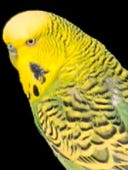Join or Sign In
Sign in to customize your TV listings
By joining TV Guide, you agree to our Terms of Use and acknowledge the data practices in our Privacy Policy.
The Life of Birds by David Attenborough Season 1 Episodes
Season 1 Episode Guide
10 Episodes 1998 - 1998
Episode 1
To Fly or Not to Fly
Wed, Oct 21, 1998 60 mins
In "To Fly or Not to Fly" (Part 1 of 10), the British naturalist travels to New Zealand and the Galapagos islands to survey birds, ranging from cormorants to kiwis, that don't fly. And in the bed of a dried-up ancient lake in Germany, he gives a quick tutorial on how birds evolved from dinosaurs some 200 million years ago.
Episode 2
The Mastery of Flight
Wed, Oct 28, 1998 60 mins
"Getting into the air is not easy," says host David Attenborough, and "Mastery of Flight" (Part two of 10) examines how birds do it. Included: pigeons and albatrosses taking off (in slow motion); a mallard flying at 40 mph; pelicans flying in formation; griffin vultures using rising thermal currents to take off; and pelicans, albatrosses and swans landing.
Episode 3
The Insatiable Appetite
Wed, Nov 4, 1998 60 mins
"The Insatiable Appetite" (Part 3) follows birds as they use their beaks to ferret out food (and eat more than their body weights each day). Among them: hummingbirds in South America; English finches; and North American sapsuckers and crossbills. Also: a woodpecker finch in the Galapagos Islands and a New Caledonian jungle crow, which uses "tools" to find food.
Episode 4
The Meat Eaters
Wed, Nov 11, 1998 60 mins
"Meat Eaters" (Part four of 10) follows carniverous birds as they stalk, sneak, swoop and scavenge for their suppers. Among them: monkey-eating eagles in Africa, vultures in Trinidad and parrots in New Zealand.
Episode 5
Fishing for a Living
Wed, Nov 18, 1998 60 mins
Attenborough travels to Gambia, Australia, Canada and the U.S. to observe birds "Fishing for a Living" (Part 5). Among them: penguins, which can dive 1000 feet down; dippers (seen "walking" under water); and darters, which resemble submarines as they stalk their prey.
Episode 6
Signals and Songs
Wed, Nov 25, 1998 60 mins
"Signals and Songs" (Part 6) explores how birds use sound and their plumage to communicate (and deter foes). Among them: the nightingale, which can "sing" 300 songs; the cowbird, whose range includes notes too high for human ears; the lyrebird, capable of imitating of other birds; and the bare-throated bell, whose high volume is necessary to pierce the dense Brazilian rain forest.

Episode 7
Finding Partners
Wed, Dec 2, 1998 60 mins
"Finding Partners" (Part 7) peeks at avian mating rituals. Included: promiscuity among British dunnocks and Australian fairy wrens; male grebes and gulls giving gifts (of nesting materials) to females; the courting calls of Brazilian calfbirds; and acrobatic performances of male blue mannakins.
Episode 8
The Demands of the Egg
Wed, Dec 9, 1998 60 mins
"The Demands of the Egg" (Part 8) follows birds as they protect their eggs before they hatch. Among them: South American waterfall swifts, which build nests behind waterfalls; Australian thornbills, which build "dummy" nests; and golden-headed cisticolas, also in Australia, which use spider-web threads as camouflage.
Episode 9
The Problems of Parenthood
Wed, Dec 16, 1998 60 mins
Some avian parents are better than others---as "The Problems of Parenthood" (Part 9) attests. Among the lucky chicks: rosella parrots, Australian magpie geese and Arabian babblers. Brown pelicans and coots, however, aren't the most caring of parents. Coots, in fact, deny food to their young.
Episode 10
The Limits of Endurance
Wed, Dec 23, 1998 60 mins
"The Limits of Endurance" explores birds' struggles to survive---sometimes in extremely hostile environments. Included: eider ducks in the Arctic, which congregate en masse, keeping waters surrounding them ice-free; sandgrouse, which survive in African deserts because their absorbent feathers enable them to transport water to their young; and purple martins living in an oil refinery in Brazil.